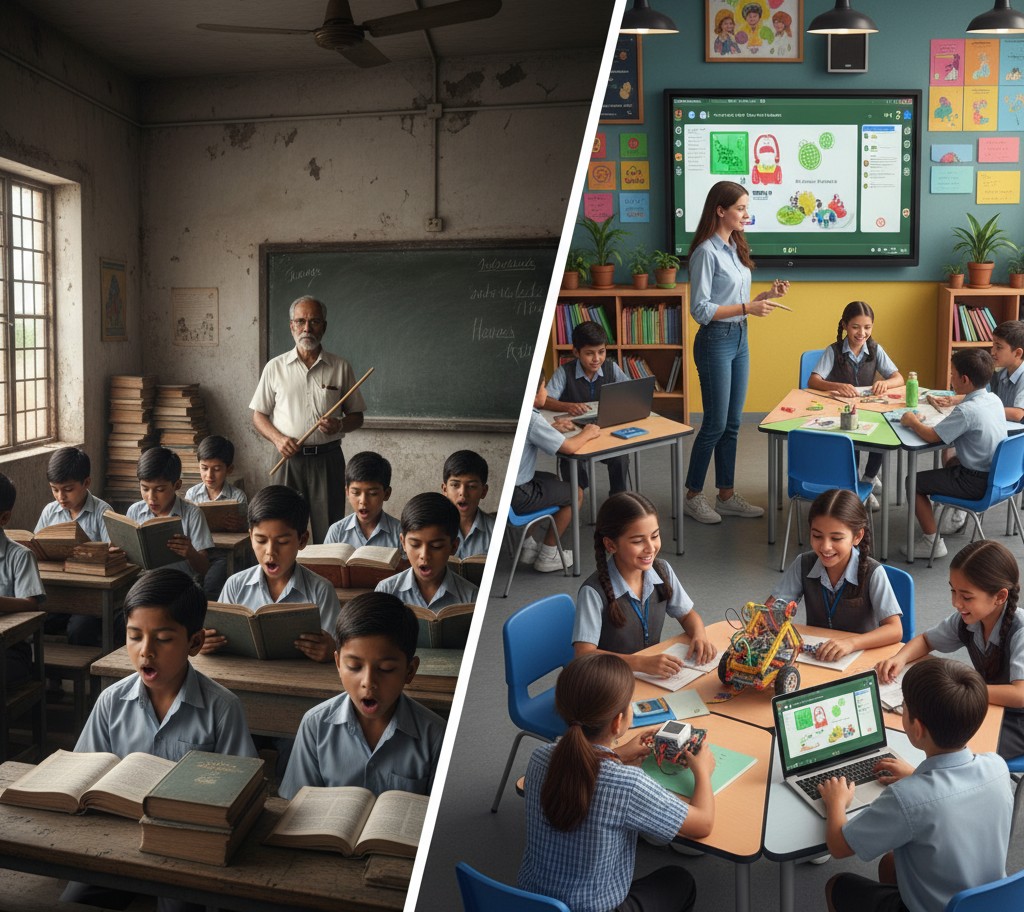The Indian Education System: Why It Needs Urgent Reform Now
Benjamin Franklin famously said, “An investment in knowledge pays the best interest.” This highlights the profound importance of education. But is the Indian education system providing the best ‘interest’ for its youth?
A well-equipped, modern education system is the building block for a nation’s growth. Today, India is in a race to perfect its educational framework, but it risks being left behind, weighed down by an outdated study pattern. The modern world operates on a simple principle: “adapt or vanish.” This applies directly to how we educate our children.
The core of our challenge was captured in a famous allegory, often attributed to Albert Einstein: “Everybody is a genius. But if you judge a fish by its ability to climb a tree, it will live its whole life believing that it is stupid.”
This metaphor is a painful reflection of the Indian education system. Decades after independence, we are still clinging to a colonial-era framework. This old model prioritizes rote memorization over creative thought and practical application. It’s the chief flaw in our system, actively blocking out-of-the-box thinking.
The Core Problem: Theory vs. Practice
The most significant problem is the glaring gap between theory and practice. For too many students, “knowledge” is limited to what can be crammed from a textbook.
This system teaches old techniques and technologies that are often useless in the current scenario. This is largely because textbooks are not upgraded in time to keep pace with global innovation.
No one can underestimate the importance of theory. It builds a foundation and provides terminology. However, our system simply stops there. We put immense emphasis on cramming theoretical concepts without paying due attention to their applicability in the real world. In contrast, many foreign education systems are built around the practical implication of that same knowledge. This gap between information and application is where our students are left behind.
Well-Intentioned Policies, Troubling Outcomes
This is not to say there haven’t been attempts at reform. After Independence, the government paid significant attention to streamlining education. The 1986 National Education Policy, for instance, aimed to fulfill varying socio-economic needs.
However, subsequent policies have had mixed, and sometimes negative, results.
The ‘No Detention Policy,’ introduced under the Right to Education (RTE) Act, is a prime example. The policy, which stated no student could be detained up to Class 8th, had a noble goal. It led to 100% enrollment at the primary level.
But the long-term aftermath has been problematic. Observers note high dropout rates at the secondary level, with some data indicating a dropout rate as high as 17% at the Class 10 level. The policy inadvertently moved the “filter” to a later, more critical stage, leaving students unprepared for high-stakes exams.
The High Cost of Stagnation: Brain Drain
When a system fails to nurture its talent—when it tells the “fish” it’s a failure for not climbing a tree—that talent will seek an ecosystem where it can swim.
This is the root of India’s “brain drain” phenomenon. The country’s youth, full of potential, are not given adequate opportunities to exhibit their talent or hone their skills. Rigid policies and corruption often block fresh, thoughtful minds.
As a result, they are moving in droves toward developed nations like the USA, Japan, and Germany in search of better opportunities. This leads to a tragic outflow of India’s intellectual capital, which is then used for the development of other nations. This brain drain is a direct consequence of the failures within the Indian education system.
The Revolution We Need: A Path to Reform
The need of the hour is a fundamental change. The Indian education system must cater to individuals based on their unique abilities and aptitudes. The emphasis must shift from mass-producing test-takers to discovering and nurturing individual talent.
This revolution needs to happen on several fronts.
1. Embrace Practicality
We must move beyond “hard work” (cramming) and embrace a “practical approach.” This includes introducing case-study-based questions and project-based learning at the school level. These methods develop a deeper, more applicable understanding of concepts.
2. Leverage Technology
We must encourage and promote e-learning platforms. A major portion of our youth devotes hours a day to social networking sites. A push toward structured e-learning, like the resources outlined in the National Education Policy 2020, can help them effectively utilize the internet for growth.
3. Focus on Holistic Development
A modern education system must prepare students for life, not just for a job. As students encounter complex sentiments and changes, relevant instruction on mental well-being, financial literacy, and social skills should be actualized by every institution.
Beyond Government: A Call for a New Mindset
Ultimately, reforming the Indian education system is not the sole responsibility of the government and policy-makers.
A true transformation requires a change in our collective outlook. As a society—parents, teachers, and students—we must begin to value creativity, critical thinking, and practical skills as much as we value marks. Only then can we reshape our education system into one that truly pays the “best interest” for generations to come.








